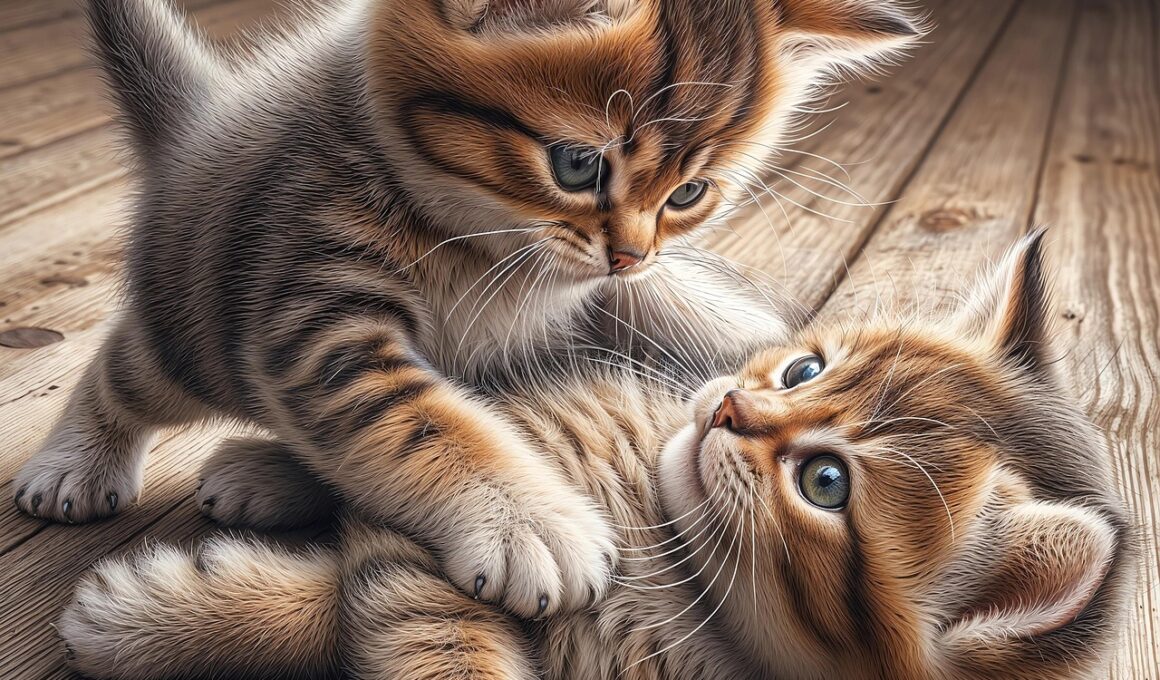Avoiding Overstimulation in Cats When Playing with Children
Creating a safe play environment is vital for both children and cats. Children often have high energy levels and may not understand the needs of a cat, which can lead to overstimulation. To begin with, it’s essential to teach children how to interact with cats gently. Explain the importance of personal space and recognizing when a cat wants to be left alone. Parents should supervise playtimes closely to ensure that interactions are positive. Moreover, consider setting up a safe area for the cat to retreat to when it feels overwhelmed. Utilizing toys that promote interactive play can help channel children’s energy while keeping the cat engaged. Consider investing in varieties of toys that allow for the cat to play safely even when children are nearby. Feather wands or laser pointers can be ideal as they allow for distance while providing fun. Children should also be taught to observe the cat’s body language. Signs like flattened ears or twitching tails can indicate discomfort and should be respected to avoid overstimulation.
In addition to monitoring playtime, selecting appropriate toys can play a significant role in reducing overstimulation. It’s crucial for both children and adults to choose toys that cater to the cat’s natural instincts. For instance, toys that mimic the movement of prey—like small balls or feathered sticks—can keep a cat entertained without putting them in a corner. Interactive toys that dispense treats can also engage cats mentally while allowing them to have their own space. Encouraging children to participate in choosing toys sends a message of responsibility. Make it a fun activity by allowing them to pick out a few toys, teaching them empathy toward their furry friends. Moreover, utilizing playtime schedules can future-proof interactions. For example, setting designated playtimes that are short can prevent the cat from becoming overstimulated. Some cats may enjoy bursts of activity followed by calm, so creating a balanced schedule is vital. Teaching children to read their cats and when to stop is essential for successful interaction. All of this together can create a nurturing environment for both children and cats.
Effective Communication with Children
Educating children on the importance of communication is critical in reducing overstimulation risks during play. Begin by encouraging children to talk about their feelings and ask questions regarding cat behavior. Engaging them in discussions helps them understand that the cat has feelings, too, which can cultivate empathy. Use storytelling as a tool to showcase how cats communicate. For example, children can be taught to recognize signs of a cat feeling overstimulated or stressed. Imagine a child yelling during play; this may escalate tension for the cat. Instead, they should be taught to observe and respond calmly. Using positive reinforcement can help motivate children to practice good interactions. Reward them when they exhibit gentle play and proper behavior. It’s essential to instill the concept of positive handling. Using light touches and gentle movements helps create an environment where both the child and cat can bond appropriately. The combination of empathy, respect, and proper communication can lead to safe, engaging experiences during playtime, nurturing friendships that flourish between cats and children.
In moments when overstimulation occurs, quick intervention is necessary. Children should be instructed clearly on what to do if they notice their cat showing signs of stress. Establishing a word or signal to indicate when to stop play can be beneficial. Simple phrases like “time out” can alert children that their cat needs a break. Show them how to gently end a play session without sudden movements or loud noises, which may frighten the cat. Educate children about what signs to watch for, such as a cat hiding or swatting. If these signs appear, they should respond immediately and allow the cat to take a break in its safe space. Discussing the importance of patience reinforces positive parenting practices. Instilling this corrective behavior addresses the pressing need to prioritize the cat’s comfort. Simple adjustments in approach can be the difference between a fun experience and a stressful one for both parties. Children can learn how to advocate for their furry friends while cultivating their emotional intelligence. Stressing the cooperation between them opens avenues for deeper connections.
Creating a Safe Physical Environment
Physical spaces where children interact with cats should be arranged thoughtfully, reducing risks of overstimulation. Designate specific areas for playtime equipped with ample safe toys, ensuring that your cat has a place to escape if beings become too much. Add cat furniture or small caves where they can retreat during play. These elements are important for preserving a cat’s comfort and security. By promoting vertical spaces like shelves or trees, you can create a sanctuary for the cat, allowing it to observe while feeling safe and less threatened. Parents should set boundaries about play areas, ensuring children understand the limits. Clear guidelines help both children and cats enjoy interactions without excessive excitement. Introducing soft surfaces such as rugs can buffer sounds that may startle cats during play. It may be advantageous to establish an indoor play zone that’s free of distractions. Additionally, securing fragile objects or electronics from high-energy play helps ensure both safety and harmony. These simple design adjustments can make significant improvements in how children and their cats interact in playful environments.
Regular moments of calm and relaxation not only benefit cats but also help manage the energy levels of children. Allocating time away from toys for both parties promotes uneventful breaks that can refresh their interactions. It’s essential to show children how to initiate calm interactions with pets. Activities such as gentle brushing or simply lying down beside the cat help in fostering connection without adding stress. Aim for quiet moments where children can see the cat relax, which illustrates a trusting bond. Creating comfy spaces for both children and cats to unwind enhances their shared experiences significantly. Consider adding soft blankets or cat beds around the play area to facilitate these bonding experiences. This approach allows children to learn the value of rest while fostering a tranquil atmosphere. Bringing distractions like soft music can create a serene environment. Incorporate relaxation routines into play schedules, so children can gauge when it’s appropriate to switch from high-energy activities to calmer pursuits. This teaches children the importance of considering their playmate’s feelings, creating long-lasting friendships rooted in understanding.
Incorporating Training and Learning
Ensuring cats and children interact harmoniously may require training and ongoing education. Parents can enforce a lifestyle centered around understanding animal behavior to empower children. Consider implementing cat training sessions where both the child and the animal can learn together. Use positive reinforcement strategies to teach cats tricks or encourage interaction. Likewise, children may enjoy being involved in these activities, fostering engagement and connection. Learning should happen in playful segments, making them look forward to scheduled times. Inform children about topics such as feline body language and vocalizations, as these insights help manage interactions sensitively. Moreover, age-appropriate books or materials can assist in building this fundamental knowledge. Enabling children to take ownership over their responsibilities creates deeper responsibilities. As they grasp the idea of their role in the cat’s well-being, it cultivates respect for the animal. By incorporating training, parents bridge the gap between child enthusiasm and feline sensitivity, enabling safer, more enjoyable play experiences. In fostering this dynamic, children become advocates for their pets, understanding the values of compassion, patience, and respect.
In conclusion, it’s vital to prioritize safety and comfort during play sessions between children and cats. Overstimulation is prevented through mutual understanding, training, and structured interactions. Teaching children how to communicate effectively with cats will cultivate empathy and practical skills. Establishing safe spaces for the cat encourages a more serene atmosphere conducive to play. Parents must actively engage in these activities, guiding children on how to create bond-building opportunities without overwhelming their pets. The right toys can transform interactions into safe, fun-filled experiences, fostering enjoyment for both children and their feline friends. Furthermore, incorporating moments for calm rest and soothing encounters promotes a more balanced relationship. Each element discussed reinforces sensitivity towards feline needs, emphasizing the importance of cooperation while playing. As guardians of both children and pets, parents have the responsibility to nurture these connections with education and awareness. Ultimately, strengthening the bonds between children and cats creates lasting memories and a sense of duty. It reminds everyone involved of the joy pets bring into lives. Promoting safety and respect will ensure happier and healthier interactions long term.


